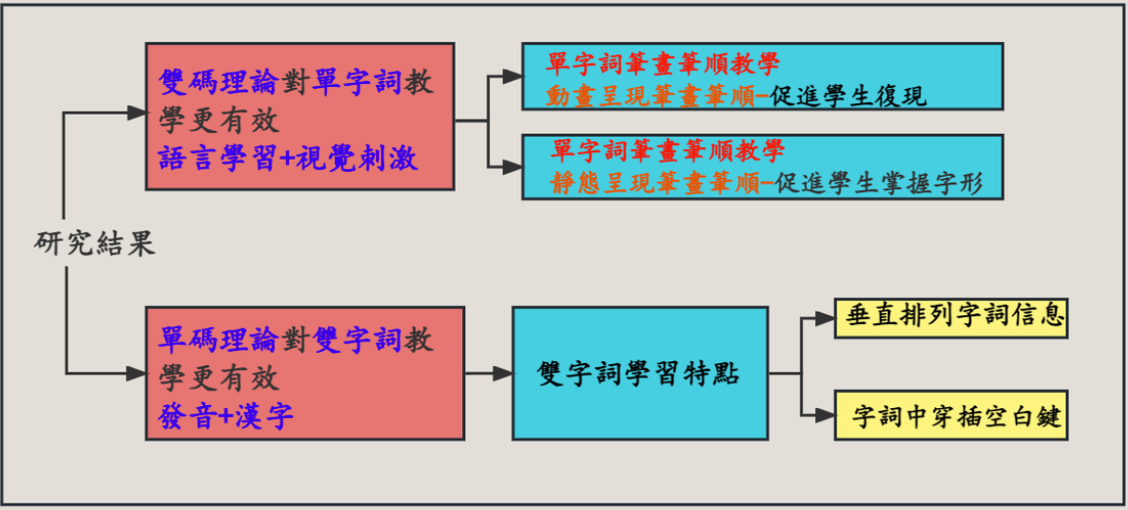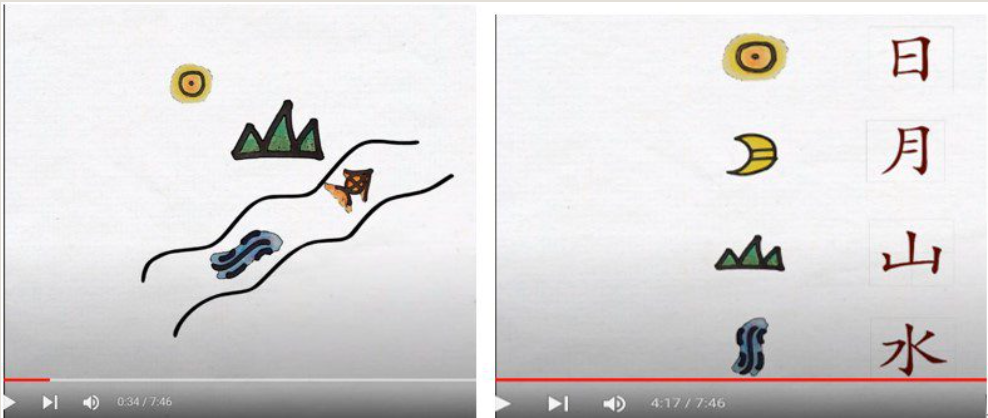
多元文化学生的语文基础薄弱,特别是字词量不足和遗忘率高的问题,值得关注。相较于同时掌握许多字词相关的教学法和教学策略,老师应着重针对不同学习条件选择不同的教学法。是次同老师分享香港大学中文教育研究中心林金锡博士与合作者的研究成果——善用「单码理论」和「双码理论」,提升单字词和双字词两种不同学习条件下的教学效果(研究成果概述如图所示)。

在学习单字词时,「双码理论」为学理基础的教学更有效。 「双码理论」指的是采用「语言学习」和「视觉刺激」,即将单字词的语音和视觉影像配对出现,进行教学。多元文化学生多为「视觉型学习者」,发音和视觉刺激能帮助学生获得「形音」的连结。例如,老师可以运用能同时呈现「象」、「蛙」、「兔」的文字和图像的字卡,帮助学生学习和巩固新字词如图所示。

此外,针对单字词学习有效的视觉刺激方法还有动画呈现汉字的来源。譬如,老师在教学「日」「月」「山」「水」字时,可用象形文字的变化辅以动画加以阐述如图所示。

*示例源于「安之中文」:《象形文字故事动画: 那山,那人,那狗》*
值得注意的是多元文化学生学习汉字书写时,常出现「笔划」和「笔顺」相关问题,老师可采用动画呈现笔划顺序帮助学生。像是运用「After Effects」如图所示制作笔划、笔顺的动画,帮助学生复现生字的笔划笔顺。

*图中示例来源于网络*
老师亦可采用静态方式呈现笔划顺序,像是运用笔划练习的生字簿如图所示,帮助学生掌握单字的字形。

在学习双字词时,「单码理论」为学理基础的教学更为有效。 「单码理论」指的是「发音」和「汉字」配对教学,即将双字词的发音和文字配对呈现。老师亦可采用词卡进行教学,但值得注意的是,由于汉字的特性,即词与词之间没有明显的边界,在多元文化学生眼中汉字就是一连串字符串,影响阅读效果,因而老师在设计和选用词卡时,应注意词卡中呈现的字词相关信息的呈现方式是否为垂直陈列,即垂直依次陈列发音、文字和(中/英文)释义等如图所示。

同时,出于汉字的特性,多元文化学生学习汉字书写时,常出现「错格」相关问题,因此老师可采用不同的方式强调「部首」和「部件」帮助学生辨识和掌握汉字。譬如,老师可采用不同的颜色标注「部首」和「部件」如图所示,并让学生在相应位置涂上相应的颜色,进而掌握学生对汉字的理解程度。

*图中示例源于陈惠琳(2020)《运用多感官教学策略提升读写障碍学生的中文读写能力个案及教材套》*
此外,字词中有效穿插「空白键」亦能有效帮助学生减少阅读困难。这种方法可用于课文调适中,老师可在制作简报时可以在每个具有独立意义的词语或词组之间加一个「空白键」如图所示,大大增强多元文化学生阅读文章的可行性。

认知学习为基础的字词教学策略帮助学生提高字词量,巩固记忆。同时,辅以有趣多样化的教学活动亦能使学生减少汉字学习的畏难心理,从中文学习中获得更多自信心和自我效能感。
E&T团队会在未来持续提供相关资讯,同老师们一起支援多元文化学生的中文学习!
参考文献:
Ke, S., & Lin, C. H. (2023). The more the merrier? A synthesis study of single-coded and dual-coded word learning in theory-driven L2 Chinese instruction. In Reading in Chinese as an Additional Language (pp. 28-42). Routledge.











 已複製鏈結
已複製鏈結